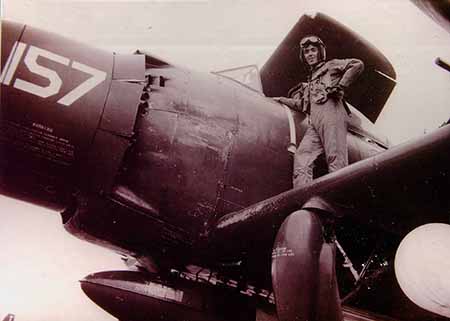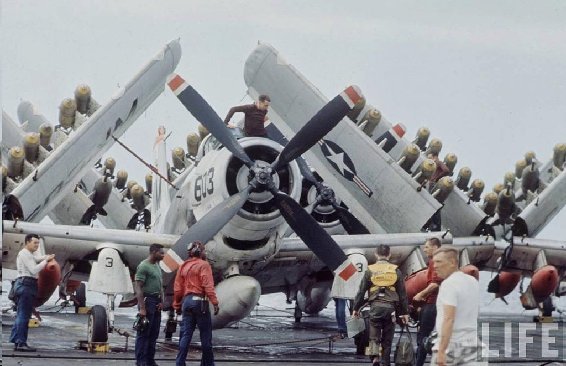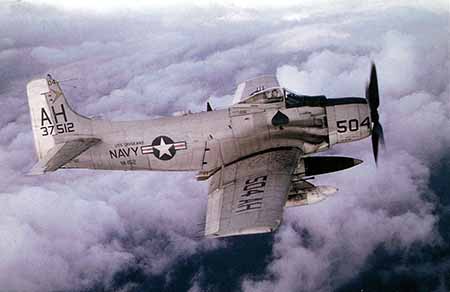
The Douglas A-1 Skyraider (formerly know as the AD- or, ‘Attack Douglas’ in Navy parlance) was a rompin,’ stompin’ airplane. It was an amazing crate, highly adaptable and the culmination of a generation of aviation technology.
Dad- that is him above on the wing preparing to mount up- used to say that his could carry more ordnance than a B-17 Flying Fortress and in straight and level flight, outrun the vaunted P-51 Mustang. The Navy (and others) had it in service from the late 1940s to the early 1980s, a remarkably long and honored career. Based on the exceptional mission duration, the USAF used them as “Sandys,” the airborne search and rescue asset in SE Asia because they could loiter over the scene of a crash for hours and hours, fending off VC and North Vietnamese troops from downed pilots.
The Skyraider was a legend- a piston powered propeller-driven anachronism in the age of jets for most of its service life, and yet produced the first shoot-down of a Vietnamese jet in that long struggle. The pilots loved them and fondly called them “Spads,” after the SPAD S.XIII, a French biplane from World War I that was produced by the Societe Pour L’Aviation et ses Derives- and hence the nick-name.
Dad had been trained as an SBD Dauntless dive-bomber pilot still in the pipeline at the end of WWII. His class would have gone on to participate in Operation DOWNFALL, the invasion of the Home Islands of Japan. His class was the third from the last to get their Wings of Gold at Pensacola. The rest of the cadets were thanked for their interest in National Defense and sent home.
Dad was offered the chance to go to the Fleet, but declined, preferring to use his GI educational benefits at Pratt Institute of Art up in New York. He loved the flying though, and stayed in the reserves after being demobilized and transitioned to the Skyraider community after moving to work at Ford’s in Detroit.
He used to tell stories about his reserve time as an AD4-J driver- a Spad model from the early 1950s. The airplane was so powerful that one hapless Squadron buddy actually managed to get airborne with the wings still folded for storage- one of the reasons that checklists exist. The pilot did not realize his mistake until he attempted to jink out of the departure pattern and went into the ground.

(This image, from LIFE magazine’s gallery of flight ops in 1966 demonstrates the amount of ordnance these beasts could carry. This one is on Bonnie Dick, the famed Bonhomme Richard (CV-31) off Vietnam).
Dad’s squadron flew on the weekends out of Naval Air Station Grosse Isle in the middle of the Detroit River and they conducted training missions around the upper Midwest. One Saturday they were tasked with conducting a simulated strike on the refinery in Toledo, OH, out of NAS Grosse Isle south of Detroit. He did the attack run on the landmark cracking tower that burned off excess natural gas.
He rolled out after his attack run, and training mission complete, cracked the canopy and lit up a Lucky. The AD’s had a cigarette lighter on the instrument panel, he said, and all the guys smoked. When the victory coffin-nail was about done, he flicked it out of the cockpit where it twirled in the slipstream. Then, slipstreams being what they are, re-entered the aircraft, falling down between his legs and coming to rest far below him on the main wing-spar glowing in the darkness.
“Shit!”
You have to remember that the Spads did not use JP-5, the Navy’s kerosene-based jet propellant. The low flash point was considered a major safety factor for shipboard operations. The Spads consumed the much more volatile 100-octane Aviation Gasoline, or AVGAS, used in high performance piston engines. Dad’s Spad was powered by the Wright R-3350-26WA Duplex Cyclone engine. His sleek airplane had suddenly become a flying Zippo lighter.
“Shit!”
He furioously cranked the pilot seat down as far as it would go and couldn’t get to the smoldering butt with his boot. Considering the fumes down there, he felt a sense of urgency. He decided to unstrap and edge his butt out of the seat so he could get down to it, reaching about his head to keep the stick on the straight and level. Relatively certain he was not going to turn into a fireball, he climbed back up, strapped in again, and returned to base at Grosse Isle.
He said he never smoked in the aircraft again, nor did he mention the incident to Mom.
Much later, in my time, some of the F-4 Phantom jocks in VF-151 confided that they smoked in the jets. With the oxygen off, they hastened to add. That could be hazardous to your health.

(This Spad is off the O-Boat, the USS Oriskany (CV-34) and is utterly serene in the heavens).
Copyright 2015 Vic Socotra
www.vicsocotra.com
Twitter: @jayare303
